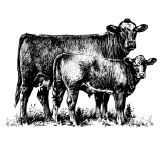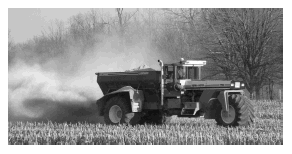

To send a message to an author, click on the author's name at the end of the article.
This Month in Ag Connection | Ag Connection - Other Issues Online
Corn Supplementation for Cows
Corn prices have substantially decreased over the course of the last several months and it may continue. With the exception of the US herd size being the same as we had in the 1950's, the drought of 2012 seems to be a bad memory for most producers.
Some producers are considering feeding corn to beef cows, for energy supplementation. Corn is packed with energy, but can lead to decreased forage digestibility if fed in too large of quantities. Increased levels of starch from corn alter the rumen "bugs" and the fermentation process. Supplementation with a degradable protein source may reduce or even eliminate corn's negative effect on fiber digestibility and improve performance.
Justin Sexten, State Beef Nutrition Specialist with MU Extension suggests using the 0.3% rule if supplementing with corn. For example: a 1000 pound cow would receive no more than 3 pounds/day of corn or this could be calculated by multiplying the average cow weight by 0.003 equaling pounds of corn per day. NOTE: It is important to know actual cow weights.
Source: Wendy Flatt, Livestock Specialist
This Month in Ag Connection | Ag Connection - Other Issues Online
While the 2014 harvest is finishing up, decisions for the 2015 crop are being made. For example, seed choices need to be made early if producers want to receive their top hybrid/variety choices. MU Extension has budgeting tools available to help producers look at the expected income and expenses for each crop. The 2015 tools should be available through regional ag business specialists by mid-November and available online by mid-December. Budgeting tools allow producers to plug in multiple prices to see how changes affect the bottom line.
MU has two resources for budgets. The first resource can be found at: http://agebb.missouri.edu/mgt/budget and contains budgets for livestock including: cow-calf for both North and South Missouri, swine, dairy, goat, and sheep. There are also budgets for row-crops, i.e. corn, irrigated corn, grain sorghum, soybean, wheat and wheat-double crop beans. Also, there are budgets for alfalfa, fescue, clover-cool season grasses, miscanthus, switchgrass, silage and baleage.
All of the budgets have baseline costs built in and allow producers to substitute in their anticipated costs to customize the budgets for their own operation.
The second source for budgets is the MU Food and Ag Policy Research Institute, http://www.fapri.missouri.edu then click on the Crop Budgets in the left-hand column. There are two ways to use these budgets: 1) click on it and get a one page budget or 2) download the grain budget generator or forage budget generator and enter your own data for more detail. The latter choice requires Microsoft Excel, but has more details such as being able to choose equipment, hired and custom labor, and much more. If you do not have Microsoft Excel, contact your local county extension office as a public computer may be available.
Source: Mary Sobba, Ag Business Specialist
This Month in Ag Connection | Ag Connection - Other Issues Online

For many beef producers, calf weaning time is quickly approaching. While the weaning process can be stressful on producers and their families, the cattle and the producer's pocket book may realize the biggest impact from a high-stress environment. Stress can cause a decrease in weight gain and with today's market prices each pound of weight is a big economic factor. Good management can reduce much of the stress making things easier on the cattle leading to potentially higher profits.
Stress and health in cattle are negatively correlated with increased stress typically resulting in a decrease in health. An increased level of stress in livestock leads to fatigue which weakens the immune system. Numerous studies conducted across the country show calves which become sick and require treatment tend to lag behind their healthy counterparts in rate of gain and carcass quality. A few tips to help reduce the stress level put on calves during weaning are as follows:
Nutrition is another important factor in weaning management. A proper nutrition plan can set the stage for success for the rest of the calf's life. The following are a few steps to ensure adequate nutrition:
A good vaccination regime is essential to animal health. Vaccinations for respiratory diseases, clostridial bacteria and a deworming product are important components of a successful vaccination program. Each individual situation could be different, so it is important to have a good working relationship with your veterinarian and let them provide recommendations. Most vaccinations require two rounds of shots, 2-4 weeks apart to be most effective.
There are many pharmaceutical and feed companies promoting weaning programs which can create a marketing advantage at selling time. These programs have set protocols giving buyers assurance calves have been handled in a manner which will lead to success in the next phase of growth. To realize the benefits of a weaning program, make sure the livestock market knows the history behind the calves at selling time.
There is no "cookie-cutter" recipe for a successful weaning program. Each operation is different and what works well for one producer may not work for another. Work closely with a veterinarian and research different strategies. Local University of Missouri Extension livestock specialists are a good source of information.
Source: Gentrie Schafer, Livestock Specialist
This Month in Ag Connection | Ag Connection - Other Issues Online
Soil testing is a valuable tool for determining the fertilizer and limestone needs of field crops, lawns and gardens. Collecting a representative soil sample is the first step in obtaining accurate, reliable results. Information about collecting a good soil sample can be found in the April 2014 edition of the NEMO Ag Connection, Vol. 1, No. 3. Once results are received, the next step is interpretation. Soil pH is a measure of the acidity of a soil. The University of Missouri Soil Testing Laboratory measures salt pH while many other laboratories measure water pH. As a general rule, water pH is 0.5 units higher than salt pH. This distinction is important as some herbicides have a water pH restriction listed on the product label.

Limestone is applied to raise soil pH when soil test reports indicate the pH is too low for optimum nutrient uptake by growing plants. For most plants the optimum salt pH is between 6.0 and 6.5. When soil pH is too high or too low nutrients are tied up in the soil and are not available for plant growth. When soil pH is at the optimum level of 6.5, 100% of the nitrogen, phosphorus and potassium which are applied as commercial fertilizer are available to the plants. As pH decreases so does nutrient availability. For example, when soil pH reaches 4.0 it takes three to four times as much fertilizer to obtain the same plant growth. Only 30% of the nitrogen, 23% of the phosphorus and 33% of the potassium applied are available for plant uptake when soil pH drops to 4.0.
Not all liming materials are created equal. When applying an acid neutralizing material, apply pounds of ENM (effective neutralizing material) rather than tons of lime. The ENM rating refers to the quality of the limestone being used to adjust soil pH and is based on the amount of the material which will react within one year. Limestone effectiveness is based on the calcium carbonate equivalent (CCE) and particle size of the material which is a measure of the purity of the limestone. The higher the CCE the less limestone will be needed to raise soil pH. Agricultural limestone sold in Missouri must have a minimum CCE of 65%. Particle size of the lime influences how well it mixes and how rapidly it reacts with the soil. The smaller the particle size, the quicker the material mixes with soil and the more effective the material is at neutralizing soil acidity. Larger particles break down slowly and will maintain soil pH for a longer time period.
When more than one cropping option is selected on a soil test report and the soil pH requirement is different for the crops, the limestone recommendation will be given for the crop needing the highest soil pH. For example, alfalfa requires a salt pH of 6.1-6.5, whereas the optimum salt pH for red clover is 5.6-6.0. If both crops are listed on the soil test result report, the limestone requirement would be given for the alfalfa cropping option.
For more information about soil testing see MU Extension Guides:
Source: Valerie Tate, Agronomy Specialist

This Month in Ag Connection | Ag Connection - Other Issues Online
Northeast Missouri Farm Bill Meeting
November 11, 2014 - 10 a.m. to 2 p.m.
Macon County Expo Center-Macon, MO
website: http://muconf.missouri.edu/farmbillseminar
contact: Karisha Devlin, phone: 660-397-2179, email: devlink@missouri.edu
Missouri Livestock Symposium
December 5 & 6, 2014
William Matthew Middle School - Kirksville, MO
website: http://www.missourilivestock.com
Missouri Crop Management Conference
December 17 & 18, 2014
Holiday Inn Select - Columbia, MO 65203
website: http://plantsci.missouri.edu/cmc/
This Month in Ag Connection | Ag Connection - Other Issues Online

The second annual Pearls of Production: Women in Agriculture Conference is set for November 7th and 8th at the Holiday Inn Express & Suites in Columbia, MO. This two day program is designed to provide a leadership and hands-on training opportunity for women in livestock production in Missouri and reach women who are playing larger roles and making key decisions in livestock production on the farm.
The first day will included discussions about several hot topics in animal agriculture including: GMO's, meat labeling, farm safety, and assuming leadership in a man's world. The evening will end with dinner and a message from the keynote speaker, Tyne Morgan, host of "US Farm Report."
On the second day, participants will choose a morning and afternoon session from discipline interests in swine, beef, small ruminants, forages, and business management. During both sessions, women will have hands-on experiences related to their field of interest.
Swine - Morning Session:
Swine - Afternoon Session:
Beef - Morning Session:
Beef - Afternoon Session:
Small Ruminants - Morning Session:
Small Ruminants - Afternoon Session:
Forages - Morning Session:
Forages - Afternoon Session:
Business Management - Morning Session:
Business Management - Afternoon Session:
Early bird registration (postmarked by October 9) is $125; and regular registration (beginning October 10) is $150. Visit http://muconf.missouri.edu/womenandagriculture/ to register and find more information.
Publishing Information
Ag Connection is published monthly for Northeast and Central areas of Missouri producers and is supported by the University of Missouri Extension, the Missouri Agricultural Experiment Station, and the MU College of Agriculture, Food and Natural Resources. Managing Editor: Mary Sobba.